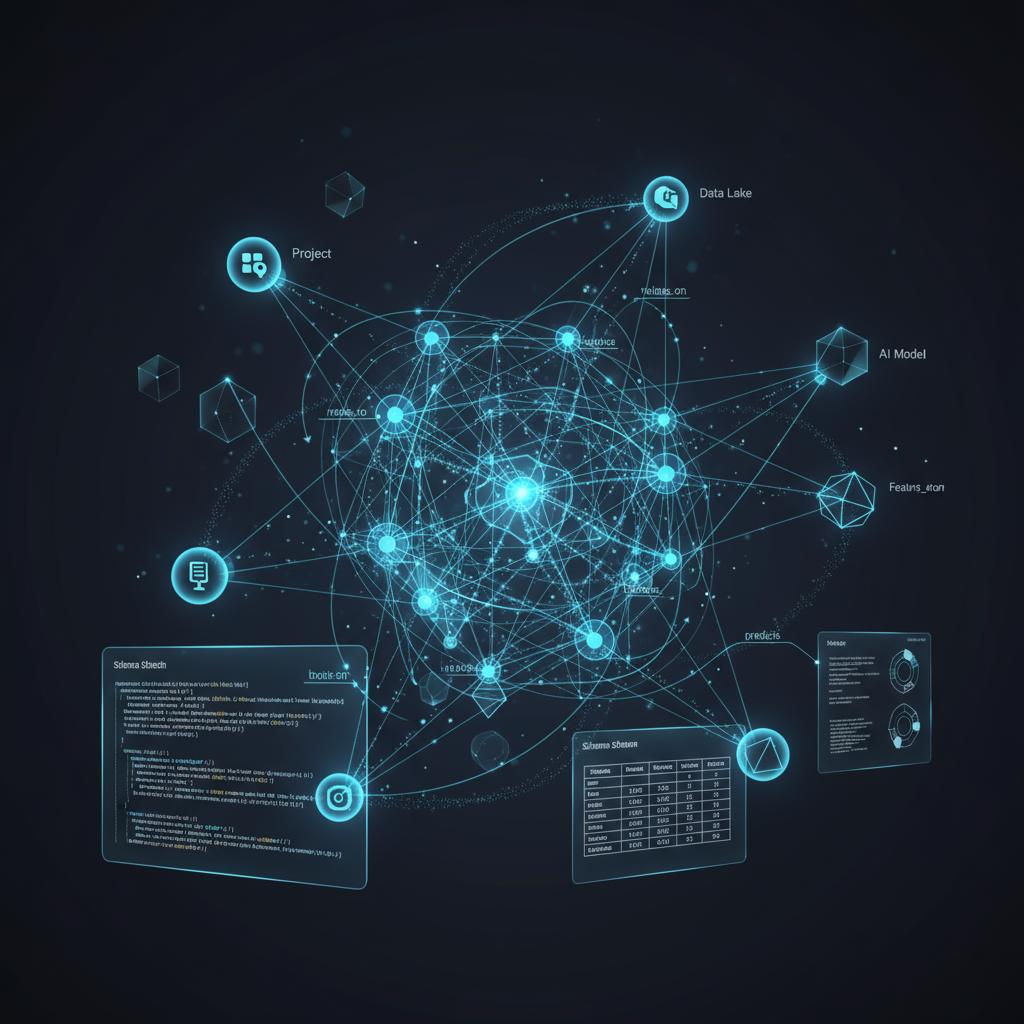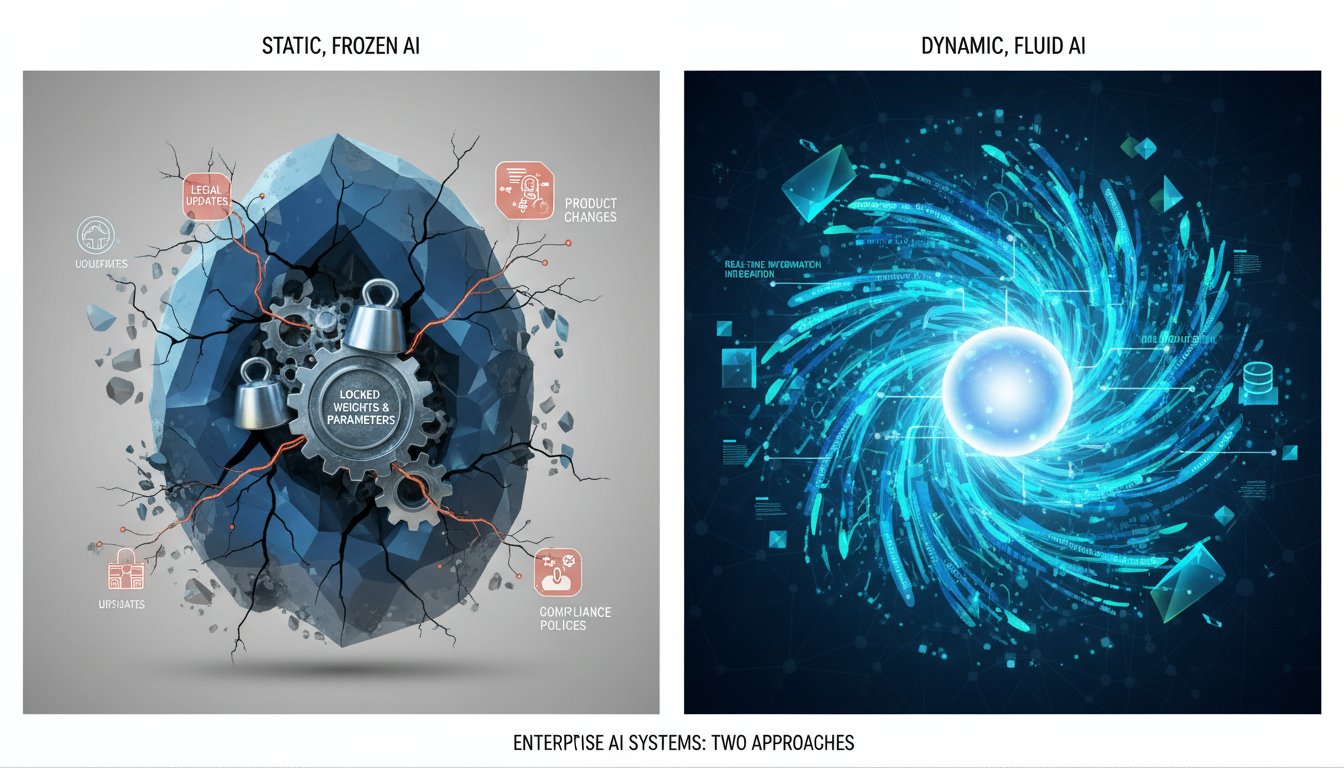Enterprise AI teams are discovering that traditional vector databases alone aren’t enough for complex knowledge retrieval. While vector similarity search excels at finding semantically related content, it struggles with understanding relationships, hierarchies, and structured knowledge that enterprises rely on. The solution? Knowledge graphs integrated with RAG systems.
Knowledge graphs represent information as interconnected entities and relationships, creating a web of structured knowledge that RAG systems can traverse intelligently. Unlike flat vector embeddings, knowledge graphs preserve context, enable multi-hop reasoning, and provide explainable retrieval paths. For enterprises managing complex domains with intricate relationships—from legal contracts to technical documentation—this approach transforms how AI systems understand and retrieve information.
This comprehensive guide will walk you through building production-ready knowledge graph RAG systems, from initial data modeling to deployment strategies. You’ll learn how to extract entities and relationships from unstructured text, design scalable graph schemas, implement hybrid retrieval combining vector and graph search, and optimize performance for enterprise workloads. Whether you’re enhancing existing RAG implementations or starting fresh, this step-by-step approach will help you harness the full potential of structured knowledge representation.
Understanding Knowledge Graph RAG Architecture
Knowledge Graph RAG fundamentally differs from traditional vector-only approaches by maintaining explicit relationships between concepts. While vector databases excel at semantic similarity, they lose the structural connections that make enterprise knowledge meaningful.
The architecture consists of three core components: the knowledge graph database, the embedding layer, and the retrieval orchestrator. The knowledge graph stores entities (nodes) and relationships (edges) extracted from your documents. Each entity can be embedded as vectors for semantic search, while preserving graph connections for relationship-based traversal.
Neo4j and Amazon Neptune lead the enterprise knowledge graph database market, with Neo4j offering superior query performance and Neptune providing seamless AWS integration. For hybrid deployments, consider Weaviate’s recent knowledge graph capabilities or Microsoft’s Azure Cosmos DB with Gremlin API.
The retrieval process combines multiple strategies: direct entity lookup, relationship traversal, and vector similarity search. This multi-modal approach enables answering complex questions that require understanding both semantic meaning and structural relationships.
Extracting Entities and Relationships from Enterprise Documents
Successful knowledge graph RAG begins with high-quality entity and relationship extraction. Modern approaches leverage large language models for few-shot extraction, dramatically reducing the manual annotation traditionally required.
Start with a clear ontology defining your domain’s key entity types and relationships. For technical documentation, focus on concepts like APIs, components, dependencies, and configurations. Legal documents require entities like parties, clauses, obligations, and references. Financial documents center on transactions, accounts, parties, and regulatory requirements.
Implement extraction using OpenAI’s GPT-4 or Anthropic’s Claude with structured prompts. Create few-shot examples that demonstrate your desired entity types and relationship patterns. For example:
def extract_entities_relationships(text, examples):
prompt = f"""
Extract entities and relationships from the following text.
Entity types: {entity_types}
Relationship types: {relationship_types}
Examples:
{examples}
Text: {text}
Output format: JSON with entities and relationships arrays
"""
response = openai.chat.completions.create(
model="gpt-4-turbo",
messages=[{"role": "user", "content": prompt}],
response_format={"type": "json_object"}
)
return json.loads(response.choices[0].message.content)
Post-process extractions to normalize entity names, resolve coreferences, and validate relationship consistency. Use fuzzy matching libraries like RapidFuzz to merge similar entities and maintain clean graph structure.
For large document volumes, implement batch processing with error handling and progress tracking. Consider using Apache Airflow or Prefect for orchestrating extraction pipelines, especially when dealing with diverse document types requiring different extraction strategies.
Designing Scalable Knowledge Graph Schemas
Effective knowledge graph schemas balance expressiveness with query performance. Over-complex schemas create maintenance burdens, while oversimplified designs lose crucial semantic distinctions.
Start with a core entity hierarchy reflecting your domain’s fundamental concepts. Technical domains typically organize around components, systems, processes, and artifacts. Business domains focus on actors, activities, resources, and outcomes. Design relationships with clear semantics—avoid generic “related_to” relationships in favor of specific types like “depends_on,” “implements,” or “contains.”
Implement schema versioning from day one. Knowledge graph schemas evolve as understanding deepens and requirements change. Use semantic versioning for schema changes, maintaining backward compatibility for minor updates while allowing breaking changes for major versions.
Consider property graphs over RDF for enterprise applications. Property graphs (Neo4j, Amazon Neptune) offer better performance and more intuitive query languages than RDF triples. However, RDF excels when integrating with existing semantic web technologies or requiring formal ontology reasoning.
Optimize for common query patterns during schema design. If your application frequently traverses multi-hop relationships, design direct relationships to minimize query complexity. Index frequently accessed properties and consider denormalizing data for performance-critical paths.
Implementing Hybrid Vector-Graph Retrieval
The power of knowledge graph RAG emerges through intelligent combination of vector similarity and graph traversal. Different query types benefit from different retrieval strategies, requiring sophisticated orchestration.
Direct entity queries leverage exact matches or fuzzy string matching. When users ask about specific components, start with entity lookup before expanding through relationships. This approach provides precise, explainable results for factual questions.
Semantic queries require vector similarity search across entity embeddings. Embed entity descriptions, documentation snippets, and contextual information to enable semantic matching. Use the same embedding model for documents and queries to ensure consistency.
Relational queries combine entity identification with graph traversal. For questions like “What systems depend on the authentication service?”, first identify the authentication service entity, then traverse incoming “depends_on” relationships.
Implement a query router that analyzes intent and selects appropriate retrieval strategies:
def route_query(query, graph_db, vector_db):
# Analyze query type
if contains_specific_entities(query):
entities = extract_mentioned_entities(query)
results = graph_db.traverse_from_entities(entities)
elif is_semantic_query(query):
embedding = embed_query(query)
results = vector_db.similarity_search(embedding)
elif requires_multi_hop(query):
start_entities = identify_starting_points(query)
results = graph_db.multi_hop_traverse(start_entities)
else:
# Hybrid approach
semantic_results = vector_db.similarity_search(embed_query(query))
graph_results = graph_db.expand_entities(semantic_results)
results = combine_and_rank(semantic_results, graph_results)
return results
Combine results using learned ranking functions. Train reranking models on your specific domain and query patterns to optimize result relevance. Consider factors like graph distance, semantic similarity, and entity importance scores.
Optimizing Performance for Enterprise Workloads
Enterprise knowledge graph RAG systems must handle concurrent users, large knowledge bases, and strict latency requirements. Performance optimization requires attention to database configuration, caching strategies, and query optimization.
Tune your graph database for read-heavy workloads. Neo4j benefits from increased page cache size and query cache tuning. Configure memory allocation based on your graph size—typically allocate 50-70% of available RAM to page cache for read-heavy applications.
Implement multi-tier caching for frequently accessed entities and relationships. Use Redis for hot entity lookups and relationship traversals. Cache expensive graph computations like shortest paths or centrality scores.
Optimize queries through index strategy and query planning. Create composite indexes for multi-property lookups and relationship indexes for traversal-heavy queries. Use query profiling to identify bottlenecks and optimize execution plans.
Consider graph partitioning for very large knowledge bases. Partition by domain, geography, or organizational structure to enable parallel processing and reduce query scope. Implement cross-partition queries carefully to maintain result completeness.
Monitor system performance with comprehensive metrics. Track query latency, cache hit rates, memory usage, and concurrent user counts. Set up alerting for performance degradation and capacity thresholds.
Integration Patterns and Best Practices
Successful knowledge graph RAG deployment requires careful integration with existing enterprise systems. Design APIs that abstract complexity while providing necessary flexibility for different use cases.
Implement GraphQL APIs for flexible query interfaces. GraphQL’s graph-native query language aligns naturally with knowledge graph structures, enabling clients to specify exactly what data they need. This reduces over-fetching and enables efficient caching.
Design robust error handling for graph queries. Graph traversals can fail due to missing relationships, circular references, or depth limits. Implement graceful degradation that falls back to alternative retrieval strategies when graph queries fail.
Maintain data lineage and provenance tracking. Enterprise applications require understanding of information sources and update histories. Store document sources, extraction timestamps, and confidence scores with each entity and relationship.
Implement incremental updates for dynamic knowledge bases. Design upsert operations that merge new information while preserving existing relationships. Use change detection to minimize unnecessary updates and maintain system performance.
Consider knowledge graph visualization for user interfaces. Tools like Cytoscape.js or D3.js enable interactive exploration of retrieved knowledge subgraphs. This transparency builds user trust and enables knowledge discovery.
Security and Governance Considerations
Enterprise knowledge graphs contain sensitive information requiring robust security and governance frameworks. Implement fine-grained access controls that respect organizational boundaries and data classification levels.
Design role-based access control (RBAC) at the entity and relationship level. Different user roles should see different subsets of the knowledge graph based on their permissions and responsibilities. Implement this through query filtering rather than separate graph instances to maintain referential integrity.
Encrypt sensitive entity properties and relationship metadata. Use application-level encryption for PII and confidential business information. Consider tokenization for frequently queried sensitive identifiers.
Implement audit logging for all graph access and modifications. Track who accessed what entities, when they accessed them, and what changes were made. This audit trail supports compliance requirements and security investigations.
Establish data retention and deletion policies. Knowledge graphs can accumulate outdated or irrelevant information over time. Implement automated cleanup processes that remove obsolete entities while preserving important historical relationships.
Regularly validate knowledge graph accuracy and completeness. Implement data quality metrics and automated validation rules to detect inconsistencies, missing relationships, and outdated information.
Building production-ready knowledge graph RAG systems requires balancing sophistication with practicality. The structured approach outlined here—from entity extraction through performance optimization—provides a roadmap for implementing enterprise-grade solutions that deliver both accuracy and explainability.
The investment in knowledge graph infrastructure pays dividends through improved answer quality, transparent reasoning, and enhanced user trust. As enterprises increasingly rely on AI systems for critical decisions, the explainable nature of knowledge graph RAG becomes a competitive advantage.
Ready to transform your enterprise RAG system with knowledge graphs? Start with a pilot implementation focusing on a single domain where relationships matter most. Document the process, measure improvements in answer quality and user satisfaction, then expand to additional domains based on lessons learned. The future of enterprise AI depends not just on what systems know, but how they structure and connect that knowledge.




